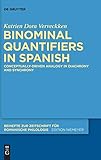Binominal Quantifiers in Spanish : Conceptually-driven Analogy in Diachrony and Synchrony / Katrien Dora Verveckken.
Material type: TextSeries: Beihefte zur Zeitschrift für romanische Philologie ; 391Publisher: Berlin ; Boston : De Gruyter, [2015]Copyright date: ©2015Description: 1 online resource (516 p.)Content type:
TextSeries: Beihefte zur Zeitschrift für romanische Philologie ; 391Publisher: Berlin ; Boston : De Gruyter, [2015]Copyright date: ©2015Description: 1 online resource (516 p.)Content type: - 9783110403718
- 9783110406832
- 9783110406733
- Spanish language -- Nominals
- Spanish language -- Qualifiers
- Spanish language -- Topic and comment
- Grammatikalisierung
- Kognitive Linguistik
- Semantik
- Syntax
- LANGUAGE ARTS & DISCIPLINES / Linguistics / Psycholinguistics
- Cognitive Semantics
- Cognitive-functional Linguistics
- Conceptualization in Quantification
- Grammaticalization (of Constructions)
- 465/.5 23
- PC4361 .V48 2015
- online - DeGruyter
- Issued also in print.
| Item type | Current library | Call number | URL | Status | Notes | Barcode | |
|---|---|---|---|---|---|---|---|
 eBook
eBook
|
Biblioteca "Angelicum" Pont. Univ. S.Tommaso d'Aquino Nuvola online | online - DeGruyter (Browse shelf(Opens below)) | Online access | Not for loan (Accesso limitato) | Accesso per gli utenti autorizzati / Access for authorized users | (dgr)9783110406733 |
Diss. KATHOLIEKE UNIVERSITEIT LEUVEN 2012.
Frontmatter -- Acknowledgements -- Contents -- List of abbreviations -- Introduction -- Part 1. Preliminaries -- 2. Framework, state of the art and methodology -- 3. Binominal quantifiers as a locus of grammaticalization -- Part 2. Diachronic case-studies – towards a constructional network model -- 4. The development of montón de, a typical locus of grammaticalization -- 5. The role of conceptual persistence and analogy in the development of BQs -- 6. Theoretical reflection: a constructional network model of the development of BQs -- Part 3. Synchronic case-studies – towards a constructional network model -- 7. QN-related schematization and N2-profiling -- 8. The motivated nature of the QN-related coselection patterns -- 9. Theoretical reflection: the notion of CIP revisited -- Part 4. Conclusions -- 10. Conclusion -- References
restricted access online access with authorization star
http://purl.org/coar/access_right/c_16ec
Quantification is central to human experience (cf. Aristotle’s Organon): the most basic aspects of human life and reasoning involve quantity assessment. This study sheds lights on a highly frequent way to express quantification in Spanish, viz. the binominal quantifier (e.g. un aluviónN1 de llamadasN2 ‘a flood of calls’) which assesses the quantity of N2 in terms of N1. This volume offers a corpus-based, cognitive-functional analysis of binominal quantifiers (BQ) in Spanish. The first part is dedicated to the development of BQs and starts from the assumption that BQs are cross-linguistically involved in grammaticalization. This monograph frames the history of BQs in Spanish in terms of constructional levels of change and highlights the complex interplay between analogical thinking and conceptual persistence. The second part motivates both the ample variation in the paradigm of quantifying nouns and their combinatorial pattern by the very same mechanism of conceptually-driven analogy. The study thus yields an innovative functional model of BQs in Spanish, in synchrony and in diachrony, with major implications for reference grammars and theory building.
Issued also in print.
Mode of access: Internet via World Wide Web.
In English.
Description based on online resource; title from PDF title page (publisher's Web site, viewed 25. Jun 2024)


